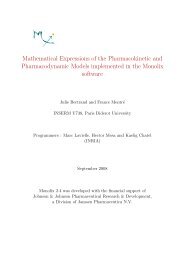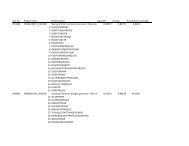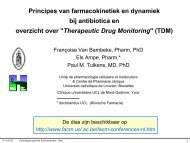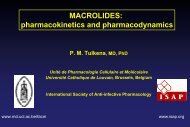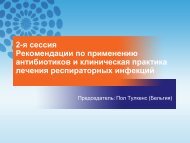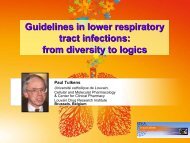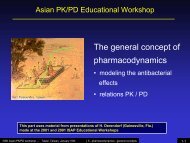Provisional PDF - Annals of Intensive Care
Provisional PDF - Annals of Intensive Care
Provisional PDF - Annals of Intensive Care
Create successful ePaper yourself
Turn your PDF publications into a flip-book with our unique Google optimized e-Paper software.
Van Herendael et al. <strong>Annals</strong> <strong>of</strong> <strong>Intensive</strong> <strong>Care</strong> 2012, 2:22http://www.annals<strong>of</strong>intensivecare.com/content/2/1/22REVIEWOpen AccessContinuous infusion <strong>of</strong> antibiotics in the criticallyill: The new holy grail for beta-lactams andvancomycin?Bruno Van Herendael 1* , Axel Jeurissen 2 , Paul M Tulkens 3 , Erika Vlieghe 4,5 , Walter Verbrugghe 6 ,Philippe G Jorens 6 and Margareta Ieven 1AbstractThe alarming global rise <strong>of</strong> antimicrobial resistance combined with the lack <strong>of</strong> new antimicrobial agents has ledto a renewed interest in optimization <strong>of</strong> our current antibiotics. Continuous infusion (CI) <strong>of</strong> time-dependentantibiotics has certain theoretical advantages toward efficacy based on pharmacokinetic/pharmacodynamicprinciples. We reviewed the available clinical studies concerning continuous infusion <strong>of</strong> beta-lactam antibioticsand vancomycin in critically ill patients. We conclude that CI <strong>of</strong> beta-lactam antibiotics is not necessarily moreadvantageous for all patients. Continuous infusion is only likely to have clinical benefits in subpopulations <strong>of</strong>patients where intermittent infusion is unable to achieve an adequate time above the minimal inhibitoryconcentration (T > MIC). For example, in patients with infections caused by organisms with elevated MICs,patients with altered pharmacokinetics (such as the critically ill) and possibly also immunocompromised patients.For vancomycin CI can be chosen, not always for better clinical efficacy, but because it is practical, cheaper,associated with less AUC 24h (area under the curve >24 h)-variability, and easier to monitor.Keywords: Continuous infusion, Intermittent infusion, Vancomycin, Beta-lactam, Antibiotic(s), Critically ill,Pharmacokinetic/pharmacodynamicBackgroundAntimicrobial resistance is emerging worldwide [1]. Inaddition there is a dramatic lack <strong>of</strong> new antimicrobialagents being explored in phase 2 or 3 clinical trials, especiallyfor Gram-negative organisms, and development<strong>of</strong> an antimicrobial with a genuinely novel mechanism <strong>of</strong>action is estimated to take years [2].These evolutions have spurred interest in maximizingthe effectiveness <strong>of</strong> our current antimicrobial armamentariumto retain its activity for the years to come. One <strong>of</strong>the ways to achieve this is through optimization <strong>of</strong> antibioticdosing regimens based on pharmacokinetic/pharmacodynamic(PK/PD) principles. Animal studies andPK/PD studies suggest that efficacy <strong>of</strong> beta-lactam antibioticsis better when administered as continuous infusion(CI) or prolonged infusion than when administeredas intermittent infusion (II), yet this remains to be* Correspondence: Bruno.van.herendael@uza.be1 Department <strong>of</strong> Microbiology, Antwerp University Hospital, Edegem, BelgiumFull list <strong>of</strong> author information is available at the end <strong>of</strong> the articleproven in clinical outcome studies. CI <strong>of</strong> vancomycinalso is increasingly popular, albeit more for practical reasonsand aiming to limit toxicity rather than for reasonsrelated to PK/PD and expected clinical efficacy. In thispaper, we therefore focus on the clinical evidence for CI<strong>of</strong> both the beta-lactam antibiotics and vancomycin incritically ill patients.Reviewβ-lactam antibioticsBeta-lactam antibiotics are “time-dependent antibiotics”.Their maximal killing rate is achieved at concentrationsthat are only about four times the minimal inhibitoryconcentration (MIC), which is a relatively low concentrationif considering the actual serum levels that areachieved by intermittent administration (typical C maxwill reach values > 80 mg/L), and the current clinicalbreakpoints <strong>of</strong> beta-lactams (i.e., the highest MIC thatan antibiotic may show against a given organism whilekeeping a high likelihood <strong>of</strong> clinical success) that rarely© 2012 Van Herendael et al.; licensee Springer. This is an Open Access article distributed under the terms <strong>of</strong> the CreativeCommons Attribution License (http://creativecommons.org/licenses/by/2.0), which permits unrestricted use, distribution, andreproduction in any medium, provided the original work is properly cited.
Van Herendael et al. <strong>Annals</strong> <strong>of</strong> <strong>Intensive</strong> <strong>Care</strong> 2012, 2:22 Page 2 <strong>of</strong> 12http://www.annals<strong>of</strong>intensivecare.com/content/2/1/22exceed 16 mg/L. Concentrations higher than four timesthe MIC do not lead to more bacterial killing [3-5]. Forbeta-lactam antibiotics, therefore, not the peak concentration(nor the area under the curve as such) correlatesbest with efficacy, but rather the fraction <strong>of</strong> the timeduring which the serum concentration <strong>of</strong> the antibioticexceeds the MIC between two successive administrations(T > MIC) [3,6]. For most non-life-threatening infectionsin nonimmunocompromised patients, a T > MIC <strong>of</strong> 40–50% is sufficient for successful clinical outcome. Animalstudies with Streptococcus pneumoniae infected nonneutropenicmice showed that survival reached a plateau(with excellent survival) if serum levels exceeded theMIC for no longer than 40–50% <strong>of</strong> the dosing interval(reviewed in [7]). A recent human study, however, suggeststhat for critically ill patients clinical outcome mightbe better if T > MIC approximates the full 100% [8]. AlthoughT > MIC is the most important parameter it alsois important to achieve a steady state concentration(Css) <strong>of</strong> at least 2.5 times the MIC and preferably 4times the MIC. Mouton and Hollander [9] showed thata Css equal to or slightly above the MIC during continuousinfusion can lead to selection <strong>of</strong> resistant subpopulationsin vitro. In a study from Alou and coworkers [10],the authors advise a Css/MIC ratio <strong>of</strong> at least 2.5, becausethey found bacterial regrowth when the Css/MICratio was 1.26, but not when it was 2.5.Several PK/PD studies with different beta-lactam antibioticshave shown that their administration by CI significantlyincreases the likelihood <strong>of</strong> maintaining serumlevels above the MIC compared with II, most notablywhen considering the highest clinical susceptibilitybreakpoints [10-18]. This is well illustrated in study byAlou and coworkers [10] who used a pharmacokineticcomputerized model to simulate concentrations <strong>of</strong> ceftazidimein human serum after administration <strong>of</strong> 6 g/dayusing either CI or II. Using isolates with MICs <strong>of</strong> 8, 16,and 32 mg/L, the authors found a T > MIC <strong>of</strong> 99.8%,69%, and 47.6%, respectively, for the bolus regimen and100% for all strains with CI. Therefore, a first populationat risk to consider for CI is patients with infectionscaused by pathogens with MICs close to the susceptibilitybreakpoint. A second at-risk population are criticallyill patients where altered physiology with increased volume<strong>of</strong> distribution (V d ) and increased drug clearancecan lead to lower initial as well as faster decreasingserum concentrations than expected for typical drugdosages [19,20]. This adds a direct pharmacokinetic argumentto the well-accepted necessity to ensure a longerT > MIC in critically ill patients compared with otherpatients for pharmacodynamic reasons [8]. A thirdpopulation at risk might be neutropenic patients. Aseries <strong>of</strong> animal studies [21-24] comparing clinical outcomeafter CI versus II in rats with pulmonary infectionshows a clear benefit in neutropenic rats in favor <strong>of</strong> CI.The daily dose needed to protect 50% <strong>of</strong> the rats frommortality was 15 times lower with CI. This effect disappearedin nonneutropenic animals.Patients in the ICU are at risk for infections withhigher MICs. For these infections, it can be quite difficultto achieve acceptable PK/PD targets with classicalintermittent dosing regimens. Even when using CI, theTable 1 Overview <strong>of</strong> studies investigating PK-parameters <strong>of</strong> continuous infusion <strong>of</strong> different antimicrobials in criticallyill patientsAntibioticMeanCss(mg/L)EnterobacteriaceaePseudomonas aeruginosaEUCAST CLSI EUCAST and CLSIBreakpoint Ratio: Css/highestpossible MIC withinsusceptibility rangeBreakpoint Ratio: Css/highestpossible MIC withinsusceptibility rangeBreakpoint Ratio: Css/highestpossible MIC withinsusceptibility rangeCeftazidime [25]6 g/24 h 75 ≤1 75 ≤4 18.75 ≤8 9.37Ceftazidime [26]4.5 g/24 h 47 ≤1 47 ≤4 11.75 ≤8 5.87Ceftazidime [27]3 g/24 h 30 ≤1 30 ≤4 7.5 ≤8 3.75Ceftazidime [28]60 mg/kg/d 19 ≤1 19 ≤4 4.75 ≤8 2.37Ceftazidime [29]4 g/24 h 40 ≤1 40 ≤4 10 ≤8 5Ceftazidime [11]6 g/24 h 63 ≤1 63 ≤4 15.75 ≤8 7.87Cefepime [30]4 g/24 h 41 ≤1 41 ≤8 5.13 ≤8 5.13Cefepime [31]4 g/24 h 13.5 ≤1 13.5 ≤8 1.68 ≤8 1.68Piperacillin [32]13.5 g/24 h 35 ≤8 4.37 ≤16 2.18 ≤16 2.18Piperacillin [33]12 g/24 h 18 ≤8 2.25 ≤16 1.125 ≤16 1.125Meropenem [15]3 g/24 h 7 ≤2 3.5 ≤1 7 ≤2 3.5EUCAST = European Committee on Antimicrobial Susceptibility Testing; CLSI = Clinical and Laboratory Standards Institute; Css = steady state concentration;MIC = minimal inhibitory concentration.
Table 2 Characteristics <strong>of</strong> studies comparing outcome for continuous versus intermittent administration <strong>of</strong> piperacillinStudy Drug Patient population Dosage Study type Outcome measure Outcome RemarksGrant 2002[49]Lau 2006[42]*Rafati 2006[16]*Lodise 2007[50]*Lorente 2009[51]Piperacillin-tazobactam Hospitalized patients 12 g/d CI (n = 47)vs. 4 x 3 g/d II(n = 51)Piperacillin-tazobactamPiperacillinPiperacillintazobactamPiperacillintazobactam(+ tobramycin7mg/kg/d)Complicated intraabdominalinfectionsSeptic, critically illpatientsPseudomonas aeruginosainfections, including bothICU patients (n = 126) andnon-ICU patients (n = 68)VAP12 g/d CI (n = 130)vs. 4 x 3 g/d II(n = 132)8 g/d CI (n = 20)vs. 4 x 3 g/d II(n = 20)3 x 3.375 g/d inextended infusions<strong>of</strong> 4 h (n = 102) vs.4or6x3.375g/dII(n = 92)16 g/d CI (n = 37) vs.4x4g/dII(n=46)Prospective, openlabelcontrolledstudyRCTRCTRetrospectivecohort studyRetrospectivecohort studyClinical cureMicrobiological cureDays todefervescenceLevel 1 costsLevel 2 costsClinical cureMortalityAdverse eventsMortalityRate <strong>of</strong> decreaseAPACHE II scoreDays todefervescence14-day mortalityAPACHE II < 17APACHE II ≥ 17Length <strong>of</strong> stay:APACHE II < 17APACHE II ≥ 17Clinical cure:MIC = 4 μg/mlMIC = 8 μg/mlMIC = 16 μg/mlNSNSCI < II(p = 0.012)NSCI < II(p = 0.028)NSNSNSNSCI > IINSNSExtendedinfusion < II(p = 0,04)NSExtendedinfusion < II(p = 0,02)NSCI > II(p =0.02)CI > II(p = 0.02)Lower antimicrobial dose in CI groupLower antimicrobial dose in extended infusiongroup Significant outcome differences only insubpopulation with high severity <strong>of</strong> illness(APACHE II ≥ 17)Significant outcome differences only in infectionscaused by pathogens with high MICs*Studies that included critically ill, ICU patients.NS = nonsignificant; MIC = minimal inhibitory concentration; CI = continuous infusion; II = intermittent infusion; APACHE II = Acute Physiology and Chronic Health Evaluation; VAP = ventilator-associated pneumonia;RCT = randomized, controlled trial; ICU = intensive care unit.Van Herendael et al. <strong>Annals</strong> <strong>of</strong> <strong>Intensive</strong> <strong>Care</strong> 2012, 2:22 Page 3 <strong>of</strong> 12http://www.annals<strong>of</strong>intensivecare.com/content/2/1/22
Van Herendael et al. <strong>Annals</strong> <strong>of</strong> <strong>Intensive</strong> <strong>Care</strong> 2012, 2:22 Page 4 <strong>of</strong> 12http://www.annals<strong>of</strong>intensivecare.com/content/2/1/22combination <strong>of</strong> pathogens with MICs close to the susceptibilitybreakpoint and critically ill patients with lower thanexpected Css (because <strong>of</strong> increased Vd and increased drugclearance) can lead to critically low Css/MIC ratios belowthe advised ratio <strong>of</strong> 2.5 to 4. An overview <strong>of</strong> studies[11,15,25-33] investigating PK-parameters <strong>of</strong> continuous infusion<strong>of</strong> different antimicrobials in critically ill patients isshown in Table 1. In most <strong>of</strong> these studies, the Css/MICratio is well above 2.5. However, for cefepime (at a submaximaldosage <strong>of</strong> 4 g/d) [31] and piperacillin (at a submaximaldosage <strong>of</strong> 12 g/d) [33], the ratio became problematically lowfor pathogens with MICs close to the susceptibility breakpointwith subsequent risk <strong>of</strong> therapeutic failure or emergence<strong>of</strong> resistance. Yet, for any MIC, continuous infusionhas a higher likelihood <strong>of</strong> attaining PK/PD targets than II. Sowhen starting empirical therapy, CI is the safer choice. Ifhowever after culture the pathogen proves to be resistant (oreven in the intermediate range) another antimicrobial shouldbe chosen. Obtaining a MIC for the causative pathogen incase <strong>of</strong> severe infection will give even more information thanrelying on “susceptible/intermediate/resistant” categoriesonly. The value <strong>of</strong> the MIC can be directly compared withthe breakpoints and can be used to guide therapy.General clinical value <strong>of</strong> CI <strong>of</strong> β-lactam antibioticsIn 2009, a meta-analysis was published <strong>of</strong> all randomizedcontrolled trials (RCT) from 1950 through November 2007comparing the clinical benefits <strong>of</strong> CI regimens <strong>of</strong> betalactamantibiotics with II regimens [34]. The meta-analysisincluded 14 RCTs with a total <strong>of</strong> 846 patients [16,17,25,35-44]. No difference was found for mortality or clinical curebetween II or CI. Yet, all but one <strong>of</strong> the included studiesused a higher drug dose in the bolus group than in the CIgroup, and the authors concluded that CI <strong>of</strong> a lower dosedbeta-lactam antibiotic might lead to the same clinicalresults as II <strong>of</strong> the same higher dosed antibiotic. Apart fromthe different daily dosages, another important limitationwas that most studies analyzed a heterogeneous populationwith underrepresentation <strong>of</strong> the critically ill, a populationwhereCIisexpectedtobeadvantageous.PenicillinsFor penicillin G and flucloxacillin, most data come fromobservational, noncontrolled studies <strong>of</strong>ten in homebasedcare settings [45-47]. Both antibiotics proved to besafe when given in CI and achieved an excellent clinicalcure rate in stable, noncritically ill patients. Only onestudy included critically ill patients, but CI was onlystarted after clinical improvement was achieved with II[47]. All previous studies had no comparator group <strong>of</strong>patients with II. One retrospective study did compareoutcome between CI (n = 78) and II (n = 28) <strong>of</strong> oxacillinfor treatment <strong>of</strong> MSSA (methicillin susceptible Staphylococcusaureus) endocarditis. They found similar results formortality (8% vs. 10%, p = 0.7) and length <strong>of</strong> stay, butmicrobiological cure at 30 days, defined as “no positivecultures within 30 days <strong>of</strong> the end <strong>of</strong> treatment”, differedsignificantly with odds ratio <strong>of</strong> 3.8 in favor <strong>of</strong> CI [48].Five clinical trials have been published in regards to CI<strong>of</strong> piperacillin-tazobactam (Table 2). Two <strong>of</strong> these foundno difference for clinical cure rates between CI and II <strong>of</strong>piperacillin-tazobactam [42,49], although Grant et al.[49] concluded that the costs in the CI group were significantlylower than in the II group. These two studiesdid not include critically ill patients. Others observedthat the severity <strong>of</strong> illness, measured by APACHE IIscores, decreased more rapidly in the CI group <strong>of</strong> septicpatients even though this group received a lower dailydosage [16]. Two retrospective cohort studies describedhigher rates <strong>of</strong> clinical cure in the CI arm, but only insubpopulations with the most critically ill patients [50]or with infections caused by more resistant organisms[51]. The last three studies were performed with criticallyill, intensive care unit (ICU) patients.CephalosporinsStudies comparing clinical outcome between CI and II<strong>of</strong> cephalosporins are listed in Table 3. Four showedcomparable clinical cure rates [17,28,38,41]. However,most used a lower daily dose in the CI arm than in theII arm [17,28,38]. In the studies by Hanes and Georges,both CI and II regimens achieved T > MIC > 90%, whichexplains the comparable outcomes [28,41].Three studies showed a clinical advantage with continuousinfusion; however, mostly only in a subpopulation.Roberts and coworkers [35] compared CI <strong>of</strong> ceftriaxoneversus II in 57 intensive care patients with sepsis andfound a significant advantage in favor <strong>of</strong> CI only in an apriori-defined subgroup <strong>of</strong> patients (n = 50) who receivedmore than 4 days <strong>of</strong> antibiotic therapy, but not in theintention-to-treat analysis that included all patients(n = 57). This subgroup analysis was performed to excludepatients who were either moribund (too ill) or did notneed antimicrobial treatment (not ill enough). A retrospectivestudy by Lorente et al. showed a greater clinicalcure rate for CI versus II <strong>of</strong> ceftazidime (and tobramycin)for the treatment <strong>of</strong> critically ill patients with ventilatorassociatedpneumonia (VAP) [52]. Both arms received alow total daily dose <strong>of</strong> 4 g/d (instead <strong>of</strong> the standard dosage<strong>of</strong> 6 g/d). This could have influenced results, becausewith suboptimal dosages the chances to attain an acceptableT > MIC are much higher with CI. Finally, an olderstudy [36] found that continuous cefamandole infusion(with carbenicillin in II) achieved a greater effectivenessthan intermittent carbenicillin infusion (with carbenicillinin II) in a subgroup <strong>of</strong> patients with persistent severeneutropenia.
Table 3 Characteristics <strong>of</strong> studies comparing outcome for continuous versus intermittent administration <strong>of</strong> cephalosporinsStudy Drug Patient population Dosage Study type Outcome measure Outcome RemarksBodey 1979[36]*Hanes 2000[28]*Nicolau 2001[38]*Lorente 2007[52]*Roberts 2007[35]Van Zanten2007[17]*Georges 2005[41]Cefamandole(+ carbenicillin6x5g/d)CeftazidimeCeftazidime(+tobramycin7mg/kg/d)Ceftazidime(+tobramycin7mg/kg)FUO in neutropenicpatientsNosocomial pneumoniain critically ill traumapatientsNosocomial pneumoniain ICU patientsVAP12g/dCI(n=74)vs.4x3g/dII(n=92)60mg/kg/dCI(n=17)vs.3x2g/dII(n=15)3g/dCI(n=17)vs.3x2g/dII(n=18)4g/dCI(n=56)vs.2x2g/dII(n=65)Ceftriaxone Sepsis 2 g/d CI (n = 29) vs.1x2g/dII(n=28)Cefotaxime COPD exacerbations 2 g/d CI (n = 47) vs.3x1g/dII(n=46)Cefepime(+ amikacin15 mg/kg/d)Severe pneumoniaor bacteremia4g/dCI(n=26)vs.2x2g/dII(n=24)RCT Clinical cure NS Significant difference in clinical cure (in favor <strong>of</strong> CI)only in subpopulation with persistent neutropenia(p = 0.03)RCTRCTRetrospective,nonrandomized,historicalchart reviewRCTLength <strong>of</strong> stayDuration <strong>of</strong>leucocytosisDays todefervescenceClinical cureMicrobiologicalcureNSNSNSNSNSClinical cure CI > II(p < 0.001)Clinical cure-ITT analysisaprioriNSCI > II(p =0.04)T > MIC > 90%inbothIIandCIgroupLowerantimicrobial dose in CI groupLower antimicrobial dose in CI groupSignificant difference in clinical cure only in an ‘a priori’defined subgroup <strong>of</strong> patients who received at least 4days <strong>of</strong> ceftriaxone therapy (to exclude patients thatwere not ill enough or too ill)RCT Clinicalcure NS LowerantimicrobialdoseinCIgroupRCT Clinical cure NS*Studies that included critically ill, ICU patients.FUO = fever <strong>of</strong> unknown origin; NS = nonsignificant; RCT = randomized, controlled trial; ITT = intention to treat; CI = continuous infusion; II = intermittent infusion; VAP = ventilator-associated pneumonia; ICU = intensivecare unit.Van Herendael et al. <strong>Annals</strong> <strong>of</strong> <strong>Intensive</strong> <strong>Care</strong> 2012, 2:22 Page 5 <strong>of</strong> 12http://www.annals<strong>of</strong>intensivecare.com/content/2/1/22
Van Herendael et al. <strong>Annals</strong> <strong>of</strong> <strong>Intensive</strong> <strong>Care</strong> 2012, 2:22 Page 6 <strong>of</strong> 12http://www.annals<strong>of</strong>intensivecare.com/content/2/1/22CarbapenemsA retrospective cohort study with 89 patients [53] comparingCI versus II <strong>of</strong> meropenem for the treatment <strong>of</strong>VAP due to Gram-negative bacilli found a significantlybetter clinical cure rate in the group with CI, especiallywhen used for Pseudomonas species and other pathogenswith elevated MIC values. The authors used 6-hinfusions, although it is generally not advised to givemeropenem in infusions longer than 3–4 h for reasons<strong>of</strong> stability. Sakka conducted a study in which 20 criticallyill patients with pneumonia were randomized to receiveeither a normal dose (3 x 1 g/d) <strong>of</strong> imipenemcilastatinby II (n = 10) or a lower dose (2 g/d) by CI(n = 10) [44]. Both regimens achieved excellent target attainmentwith T > MIC 100% for all patients, whichexplains the similar outcomes with one patient who diedin the CI group and two patients in the II group. Bothstudies are listed in Table 4.With regards to the threat <strong>of</strong> the emergingcarbapenemase-producing Enterobacteriaceae, it has beensuggested in a recent review that carbapenemase-producingKlebsiella pneumoniae with a MIC up to 4 mg/L (higherthan the EUCAST (European Committee on AntimicrobialSusceptibility Testing) susceptibility breakpoint <strong>of</strong> 2 mg/Land the CLSI (Clinical and Laboratory Standards Institute)susceptibility breakpoint <strong>of</strong> 1 mg/L can still be treated withcarbapenems if they are given in an extended infusion andhigher dosage regimen [54]. This could create a treatmentoption in situations where alternatives are extremely limited.TemocillinOnly one study has been published concerning CI <strong>of</strong> theniche antibiotic temocillin [13]. Temocillin remainsstable and therefore active in CI and is compatible withaminoglycosides (but not with several other antibiotics).Moreover, the standard dose <strong>of</strong> 4 g/d yields stable serumconcentrations >16 mg/L, the breakpoint <strong>of</strong> temocillinfor Enterobacteriaceae. Unfortunately, the study was notpowered to compare clinical outcome. A study using a6-g/d dosage in the ICU with a measure <strong>of</strong> clinical outcomeis now near completion.CI <strong>of</strong> beta-lactam antibiotics: DiscussionThe available clinical evidence, also in critically ill patients,does not show a conclusive and significant benefit in favor<strong>of</strong> CI. This might be due to the fact that CI is only likely tohave clinical benefits in the subpopulation <strong>of</strong> patients forwhom II is unable to achieve an adequate T > MIC: for example,in patients with infections caused by borderline susceptibleorganisms, patients with elevated drug clearance orincreased V d (such as the critically ill), and possibly also immunocompromisedpatients. These populations are difficultto include in homogenous cohorts, and the underlyingpathologies may obscure the final picture. However, it is fairto say that in the small numbers <strong>of</strong> clinical studies that didshow an advantage in favor <strong>of</strong> CI, this effect was onlypresent or more pronounced in a subpopulation <strong>of</strong> themost critically ill or patients with infections caused bypathogens with elevated MICs. An important limitation <strong>of</strong>most <strong>of</strong> the older studies is that they are primarily designedto prove that a lower dose <strong>of</strong> an antibiotic given in CI canbe equally effective as a higher dose given in an intermittentbolus regimen and consequently use lower dosages in theCI arm. Finally, some studies use a second antibiotic, whichcould be responsible for bias.Future studies should ideally include a homogeneouspopulation and PK/PD analysis (including the MICs <strong>of</strong> theresponsible pathogens and therapeutic drug monitoring) toknow which patients attain PK/PD targets and how this islinked with either infusion regimen and/or outcome. However,serum level determinations for beta-lactam antibioticsare not routinely available, and therefore, PK/PD analysishas only recently gained attention in the ICU world.Apart from clinical efficacy, there are some otheradvantages in favor <strong>of</strong> CI. Several studies show that thecosts associated with CI are lower than with II [49,55].There also is some evidence that tissue penetrationmight be better with CI. Roberts et al. found that concentrationat the subcutaneous tissue was higher whenmeropenem was administered by CI than when it wasadministered by II in critically ill patients [15]. Anotherstudy shows that the penetration <strong>of</strong> ceftazidime inpatients with severe abdominal infections was betterwith CI than with II [26].Table 4 Characteristics <strong>of</strong> studies comparing outcome for continuous versus intermittent administration <strong>of</strong>carbapenemsStudy Drug Patientpopulation*Lorente2006 [53]*Sakka2007[44]MeropenemImipenem-cilastatinVAP with gramnegative bacilliNosocomialpneumoniaDosage Study type Outcomemeasure4 g/d CI (n = 42)vs. 4 x 1 g/d (n = 47)2 g/d CI (n = 10)vs. 3 x 1 g/d (n = 10)*Studies that included critically ill, ICU patients.VAP = ventilator-associated pneumonia; RCT = randomized, controlled trial.Retrospectivecohort studyOutcomeClinical cure CI > II(p < 0.001)RemarksRCT Clinical cure NS Lower antimicrobial dose inCI groupT > MIC = 100 % inboth II and CI group
Van Herendael et al. <strong>Annals</strong> <strong>of</strong> <strong>Intensive</strong> <strong>Care</strong> 2012, 2:22 Page 7 <strong>of</strong> 12http://www.annals<strong>of</strong>intensivecare.com/content/2/1/22Table 5 List <strong>of</strong> drugs that are incompatible with different time-dependent antibiotics when given trough the sameintravenous line (Y-site incompatibilities)Time-dependent antibioticIncompatible drugs (should not be given trough the same intravenous line)Flucloxacillin [64]Clarithromycin, lorazepam, midazolam, vancomycinCeftazidime [61,64]Acetylcysteine, nicardipine, midazolam, prop<strong>of</strong>ol, and vancomycinCefepime [62,64]Piperacillin-tazobactam [64]Meropenem [64]Imipenem [64]Erythromycin, prop<strong>of</strong>ol, midazolam, phenytoin, piritramide, theophylline, nicardipine, N-acetylcysteine,vancomycin, and a concentrated solution <strong>of</strong> dobutamineAcyclovir, amiodarone, amphotericin B cholesteryl sulfate complex, azithromycin, dobutamine,ganciclovir, haloperidol, vancomycinAcyclovir, amphotericin B, diazepam, ondansetron, doxycyclineAllopurinol, amiodarone, amphotericin B cholesteryl sulfate complex, azithromycin, fluconazole,lorazepam, midazolam,Temocillin [13] Other beta-lactam antibiotics, vancomycin, cipr<strong>of</strong>loxacin, clindamycin, prop<strong>of</strong>ol, midazolam,nicardipine, ranitidine, vitamin KVancomycin [unpublished data by Ampe E,article in preparation]Flucloxacillin, temocillin, piperacillin-tazobactam, cephalosporins, imipenem, moxifloxacin, prop<strong>of</strong>ol,valproate, phenytoin, theophylline, furosemide, methylprednisoloneCI <strong>of</strong> beta-lactam antibiotics: Practical considerationsThe antibiotic dosage should be adjusted to achieve aserum steady state target concentration approximatelyfour times the MIC <strong>of</strong> the pathogen, and a loading doseshould be administered to reach a steady state more rapidly.Several formulas have been proposed for calculation<strong>of</strong> loading dose and total daily dose [56]:Total daily dosage (mg) = 24 (h) x total body clearance(L/h) x target Css (mg/L)Loading dose (mg) = target peak concentration (mg/L)x volume <strong>of</strong> distribution (l)AUC 24h = Total daily dosage /[{(creatinine clearance x0.79) + 15.4} x 0.06]However, the value <strong>of</strong> these formulas is limited in a criticallyill population; they presume knowledge <strong>of</strong> volume <strong>of</strong>distribution (V d ) and total body clearance (TBC), which isproblematic in an ICU population. In critically ill patients,the V d is elevated and difficult to predict. Second, the TBC<strong>of</strong> beta-lactams is not always readily predictable from thevalue <strong>of</strong> creatinine clearance (even for antibiotics such asceftazidime that are essentially eliminated by the kidney),and moreover, in the critically ill there is no readily availablemethod to measure accurately the glomerular filtrationrate (GFR) [57]. The risk <strong>of</strong> underdosing is certainlyhigher than the risk <strong>of</strong> possible toxicity in ICU patients.Because no clinical or biological variable can predict betalactamconcentrations in critically ill patients, we agreewith other authors that therapeutic drug monitoring <strong>of</strong>beta-lactam antibiotics might be necessary in this population[58]. Because beta-lactams are rather safe drugs, apractical approach commonly used is to start with a loadingdose equal to the first dose normally administeredwhen using II, followed immediately by CI using the sametotal daily dose as in II (note that in doing so, one createsessentially a single serum peak equivalent to what isobtained repeatedly with II).Not all beta-lactam antibiotics are stable enough for a24-h infusion. Piperacillin [59], temocillin [13], andaztreonam [59,60] are stable at room temperature for atleast 24 h. Ceftazidime and cefepime are stable for 24 hat 25°C, but only for 8 h and 13 h, respectively, at 37°C[59,61,62]. This means they can be used as 24-h infusionwithout problems if temperature does not exceed 25°C,but home administration with portable pumps next tothe body or hospital administration in regions or periods<strong>of</strong> warm climate can pose problems because <strong>of</strong> highertemperatures. Meropenem, doripenem, and especiallyimipenem are less stable and should only be given asextended 3- or 4-h infusions [63]. Amoxicillin is stableat room temperature for 8 h [64] and penicillin for 12 h[65]. Certain physical or chemical incompatibilities withother drugs for infusion through the same intravenousline (Y-site infusion) have been described. Most notableis the incompatibility with vancomycin for most betalactamantibiotics. An overview <strong>of</strong> all incompatibilities islisted in Table 5. If concomitant administration <strong>of</strong> Y-siteincompatible drugs is necessary, they should be administratedtrough separate intravenous lines.VancomycinVancomycin has a different PK/PD pattern. Like betalactamantibiotics, vancomycin also exhibits slow andtime-dependent killing during in vitro experiments.However, unlike the beta-lactams, vancomycin has moderatelylong postantibiotic effects (i.e., withdrawal <strong>of</strong> theantibiotic is not immediately followed by bacterial regrowth).Therefore, it becomes less important for serumconcentrations to remain above the MIC all the time [66].Moreover, vancomycin has a much longer serum half-lifethan most β-lactams, which makes the drug remain abovethe MIC for most <strong>of</strong> the administration interval (especiallyif considering the recently revised clinical breakpoints <strong>of</strong>
Van Herendael et al. <strong>Annals</strong> <strong>of</strong> <strong>Intensive</strong> <strong>Care</strong> 2012, 2:22 Page 8 <strong>of</strong> 12http://www.annals<strong>of</strong>intensivecare.com/content/2/1/22vancomycin that have been decreased to ≤2 mg/L for susceptibleand to >2 for resistant to avoid recommendingthe use <strong>of</strong> vancomycin against organisms with higherMICs that would only poorly respond to the antibiotic).<strong>Care</strong>ful animal studies where T > MIC could be unambiguouslyseparated from other PK parameters (which isdifficult to obtain in human studies) showed that it is actuallyAUC 24h /MIC (area under the curve over 24 h) thatbest predicts clinical efficacy [67-70].AUC 24h is a parameter that is more difficult to graspthan the T > MIC, but it is proportional to the total dailydosage (TDD) and inversely proportional to the creatinineclearance (CrCl) [69]. Consequently the AUC 24h will increaseif a greater TDD is given, irrespective <strong>of</strong> continuousor intermittent dosing. An AUC 24h /MIC > 350 was associatedwith clinical success and an AUC 24h /MIC > 400with faster bacterial eradication in patients receivingvancomycin for Staphylococcus aureus pneumonia [69]. Incontinuous infusion, the AUC 24h is simply the product <strong>of</strong>the actual serum concentration x24. Based on the aboveobservations concerning the required AUC 24h /MIC ratio,it means that a stable serum level <strong>of</strong> 14 to 18 times theMIC must be maintained to achieve optimal efficacy.Clinical value <strong>of</strong> CI <strong>of</strong> vancomycinA prospective, randomized trial in 114 patients treatedfor severe staphylococcal infections compared outcome,safety, and cost <strong>of</strong> CI versus II infusion <strong>of</strong> vancomycin[71]. Outcome and safety were similar between the twogroups, but with CI target concentrations were achievedmore quickly, there was less variability <strong>of</strong> AUC 24h values,and costs were lower. Vuagnat et al. conducted a nonrandomized,prospective trial with 44 patients whorequired high-dose vancomycin for treatment <strong>of</strong> osteomyelitis[72]. Twenty-one patients received vancomycinthrough II and 23 through CI. Outcome was equal withboth regimens but with CI target concentrations wereachieved more quickly, there was less variability <strong>of</strong>serum concentrations and also less adverse reactionswere seen, including renal injury. A small, retrospectivestudy in critically ill patients found that CI was associatedwith a faster decrease in leukocyte count and clinicalseverity score but not with differences in morbidityor mortality [73]. One matched cohort study reportedlower mortality rates for critically ill patients with VAPreceiving vancomycin in CI (25% vs. 55%). Multiple regressionanalysis <strong>of</strong> the data confirmed that CI was associatedwith improved survival. Unfortunately, this studywas not designed to compare CI and II and thus PK/PDdata are lacking [74].Two major clinical studies compared nephrotoxicitybetween different vancomycin dosing regimens [75,76].In a study in which 167 outpatients received vancomycinthrough CI (n = 112) or through II (n = 55), Ingram et al.found that CI is associated with a slower onset, but nota lower prevalence (15.6%), <strong>of</strong> nephrotoxicity [75]. Anonsignificant tendency toward less nephrotoxicity infavor <strong>of</strong> CI was seen in 149 patients after cardiac surgery[76].Byl et al. compared the pleural and serum vancomycinconcentrations in 16 patients receiving continuous orintermittent vancomycin infusion and found no differencefor AUC 24h between the two groups, but antibioticlevels were more sustained with CI [77].CI <strong>of</strong> vancomycin: DiscussionThe actual data show no difference in clinical outcomebetween continuous and intermittent dosing regimens.But for vancomycin, in contrast to the beta-lactams, weexpected this; as we have seen, AUC 24h /MIC is the PK/PD parameter best predictive <strong>of</strong> clinical efficacy and isdependent only on TDD and renal function.If not for attaining better clinical efficacy, what otherreasons are there for choosing a CI regimen? The studyfrom Wysocki et al. suggests that CI is cheaper, logisticallymore convenient, achieves target concentrations faster,and results in less variability <strong>of</strong> the AUC24 compared withII [71]. On a busy nursing ward, it may be easier to obtaina reliable Css than a reliable through concentration, becausethe first can be obtained at almost any time duringthe administration period.The subject <strong>of</strong> nephrotoxicity is <strong>of</strong> growing importance,because there is a tendency toward higher, and potentiallymore nephrotoxic, dosing <strong>of</strong> vancomycin to attain theadvocated PK/PD-target <strong>of</strong> AUC 24h > 400/MIC. As mentioned,two studies have suggested that CI might be associatedwith a slower onset <strong>of</strong> nephrotoxicity [75,76].Wysocki et al. [71] also states that continuous infusionwith a target Css <strong>of</strong> 20–25 mg/L is safe, and a recent metaanalysis<strong>of</strong> available data found that CI is associated with asignificantly lower risk <strong>of</strong> nephrotoxicity compared with II[78]. However, a recent, retrospective, cohort study <strong>of</strong> 129patients who received vancomycin in CI with a target Css<strong>of</strong> 15–25 μg/mL contradicts the belief that CI is lessnephrotoxic than II and finds a high proportion <strong>of</strong> patientswith acute kidney injury (29.5%) [79]. This study had nocomparator group <strong>of</strong> patients with II. Data on toxicity forcontinuous versus intermittent infusion <strong>of</strong> vancomycin areconflicting, and no conclusive recommendations can bemade [80].Because there is no evidence for outcome benefit andbecause data on renal toxicity are conflicting, recentguidelines from the Infectious Diseases Society <strong>of</strong> America(IDSA) concerning the treatment <strong>of</strong> methicillinresistantStaphylococcus aureus (MRSA) do not supportthe generalized use <strong>of</strong> a continuous infusion for vancomycinin these circumstances [81].
Van Herendael et al. <strong>Annals</strong> <strong>of</strong> <strong>Intensive</strong> <strong>Care</strong> 2012, 2:22 Page 9 <strong>of</strong> 12http://www.annals<strong>of</strong>intensivecare.com/content/2/1/22CI <strong>of</strong> vancomycin: Practical considerationsRecent consensus recommendations suggest a vancomycinstarting dose <strong>of</strong> 15–20 mg/kg every 8–12 h for II with aloading dose <strong>of</strong> 25–30 mg/kg [70]. These recommendationsfor loading dose and TDD can be applied to CI or thedosages can be individualized according to PK/PD targets.The formulas proposed for calculation <strong>of</strong> individualizeddosages are the same as those mentioned for beta-lactamantibiotics. These formulas also suffer from the same shortcomings,as mentioned, for beta-lactam antibiotics and arenot readily applicable in critically ill patients. However, theycan be used to demonstrate the thin line between therapeuticand toxic vancomycin dosages. For example, attainingan AUC 24h /MIC <strong>of</strong> 400 for a patient with a CrCl <strong>of</strong>100 ml/min and a pathogen with a MIC <strong>of</strong> 1 mg/L wouldrequire a total daily dose <strong>of</strong> 2,300 mg <strong>of</strong> vancomycin. For aMIC <strong>of</strong> 2 mg/L (the EUCAST susceptibility breakpoint forvancomycin against MRSA), this would mean a total dailydose <strong>of</strong> 4,500 mg, which approximates a Css <strong>of</strong> 31.25 mg/L.Ingram et al. [82] showed that the risk for development <strong>of</strong>acute kidney injury greatly increases when Css exceeds28 mg/L and 31.5 mg/L is already well above this safetylimit. A target Css less than 28 mg/L is achievable only fora pathogen with a MIC <strong>of</strong> maximal 1.8 mg/L. If the MIC <strong>of</strong>the pathogen is not known, an empirical target Css <strong>of</strong> 20–25 mg/L can be used. Jeurissen showed that to achieve atarget <strong>of</strong> 25 mg/L a TDD <strong>of</strong> 3,000 mg with a loading dose<strong>of</strong> 1,000 mg should be used in critically ill patients [83]. Because<strong>of</strong> the difficulties in predicting correctly both the V dand the clearance <strong>of</strong> vancomycin, it remains advisable tomeasure serum levels during the first days <strong>of</strong> therapy sothat adjustments can be made rapidly.Vancomycin is stable at room temperature for at least24 h and can be given in CI. However, the drug is incompatiblewith several other drugs, including most notablyβ-lactams [64]. Clinicians, therefore, are advised toinfuse vancomycin through a separate line than the oneused for other drugs. Incompatibilities are listed inTable 5. Because <strong>of</strong> the risk <strong>of</strong> red-man syndrome, it alsois advisable to administer the loading dose in no lessthan 1–2 h and to use only diluted solutions <strong>of</strong> vancomycin(typically no more than 10 g/L in 5% glucose).Drawbacks <strong>of</strong> continuous infusionMost notable disadvantages <strong>of</strong> continuous infusion arerelated to the stability <strong>of</strong> the administered drug, especiallyfor carbapenems, and incompatibilities with other drugsas mentioned before. For carbapenems, this limits theiruse as “prolonged infusion” (3–4 h), unless solutions areregularly replaced or special precautions are used, such asmaintaining the solutions at 4°C. For ceftazidime, the instabilityissues will become important if the surroundingtemperature exceeds 25°C and may necessitate a frequentreplacement (every 8 h) <strong>of</strong> the solutions. In the ICU, theincompatibility problem is partly overcome through thefrequent use <strong>of</strong> multiple lumen central venous catheters.However, on a classic nursing ward where most patientshave standard peripheral venous catheters, this can posepractical problems. Clinicians should be advised to checkfor potential incompatibilities before starting CI (e.g., referto the lists in [61,62]) and, in case <strong>of</strong> difficulty, to resort toextended dosing regimens (thus alternating the infusion <strong>of</strong>the antibiotic with that <strong>of</strong> the incompatible drug(s).Another caveat concerns specifically the beta-lactams,which is the risk <strong>of</strong> neurological toxicity (encephalopathy,convulsions). Beta-lactams are known to cause such adverseeffects, but most published studies abut CI did notreport its occurrence in patients. Nevertheless, there areanecdotal reports for neurological adverse effects causedby cefepime given by CI (especially if its concentrationsexceed 80 mg/L), for reasons that could be related both tothe drug intrinsic toxic potential and the liberation <strong>of</strong> degradationproducts (see discussion in [62]). Conversely, noadverse effect was noted for temocillin, including inpatients with stable levels between 80 and 140 mg/L.Nevertheless, the clinician should remain aware <strong>of</strong> thisrisk, especially if deciding to aim at a high serum levels,because <strong>of</strong> the presence <strong>of</strong> an organism with a high MIC.ConclusionsThe pursuit for clinical advantages <strong>of</strong> CI is still open.There is compelling evidence from PK/PD studies that CI<strong>of</strong> beta-lactam antibiotics is superior to II for attainment<strong>of</strong> PK/PD targets. Clinical studies have been less convincingand, although they show at least comparable outcomesbetween different regimens, they have not beenable until now to show a significant benefit in favor <strong>of</strong> CI.However, several studies show important shortcomings,such as the use <strong>of</strong> lower antimicrobial dosages in the CIarm. We conclude that CI <strong>of</strong> beta-lactam antibiotics is notnecessarily more advantageous for all patients. The benefitis probably most pronounced in infections with more resistantpathogens and in subpopulations, such as criticallyill or immunocompromised patients. This remains to beproven in well-designed, clinical studies with simultaneousin depth PK/PD analysis.For vancomycin, CI can be chosen, not always for betterclinical efficacy, but because it is practical, cheaper,associated with less AUC24h-variability and easier tomonitor. Moreover, it might be associated with a sloweronset <strong>of</strong> nephrotoxicity. There is, however, still more todebate about this specific point, and we would stronglyencourage more detailed studies in this context.AbbreviationsCI: Continuous infusion; II: Intermittent infusion; T > MIC: Time above theminimal inhibitory concentration; PK/PD: pharmacokinetic/pharmacodynamic; MIC: minimal inhibitory concentration; AUC 24h : Areaunder the curve over 24 h; V d : Volume <strong>of</strong> distribution; TBC: Total body
Van Herendael et al. <strong>Annals</strong> <strong>of</strong> <strong>Intensive</strong> <strong>Care</strong> 2012, 2:22 Page 10 <strong>of</strong> 12http://www.annals<strong>of</strong>intensivecare.com/content/2/1/22clearance; RCT: Randomized controlled trial; MSSA: Methicillin susceptibleStaphylococcus aureus; VAP: Ventilator-associated pneumonia;EUCAST: European Committee on Antimicrobial Susceptibility Testing;CLSI: Clinical and Laboratory Standards Institute; ICU: <strong>Intensive</strong> care unit;GFR: Glomerular filtration rate; CrCl: Creatinine clearance; TDD: Total dailydosage; Css: Steady state concentration; LD: Loading dose; C peak : Peakconcentration; FUO: Fever <strong>of</strong> unknown origin; NS: Nonsignificant;ITT: Intention to treat; APACHE-II: Acute Physiology and Chronic HealthEvaluation.Competing interestsThe authors declare that they have no competing interests.Author's contributionsBVH wrote the original draft <strong>of</strong> the paper. All authors have made substantialcontributions to the analysis and interpretation <strong>of</strong> the literature survey, havebeen involved in revising the manuscript for important intellectual content,and have given final approval <strong>of</strong> the version to be published. Each authorhas participated sufficiently in the work to take public responsibility forappropriate portions <strong>of</strong> the content. All authors read and approved the finalmanuscript.AcknowledgmentsIn loving memory <strong>of</strong> Dr. Axel Jeurissen.The authors thank clinical pharmacist John Leys, Antwerp University Hospital,for his help concerning drug incompatibilities.Author details1 Department <strong>of</strong> Microbiology, Antwerp University Hospital, Edegem, Belgium.2 Department <strong>of</strong> Microbiology, GZA St. Vincentius Hospital, Antwerp, Belgium.3 Cellular and Molecular Pharmacology and Centre for Clinical Pharmacy,Louvain Drug Research Institute, Université catholique de Louvain, Brussels,Belgium. 4 Department <strong>of</strong> Tropical Diseases, Antwerp University Hospital,Edegem, Belgium. 5 Institute <strong>of</strong> Tropical Medicine, Antwerp, Belgium.6 Department <strong>of</strong> <strong>Intensive</strong> <strong>Care</strong> Medicine, Antwerp University Hospital,Edegem, Belgium.Received: 28 February 2012 Accepted: 2 July 2012Published: 2 July 2012References1. Carlet J, Collignon P, Goldmann D, Goossens H, Gyssens IC, Harbarth S,Jarlier V, Levy SB, N'doye B, Pittet D, Richtmann R, Seto WH, Van der MeerJW, Voss A: Society's failure to protect a precious resource: antibiotics.Lancet 2011, 378(9788):369–371.2. Boucher HW, Talbot GH, Bradley JS, Edwards JE, Gilbert D, Rice LB, Scheld M,Spellberg B, Bartlett J: Bad bugs, no drugs: no ESKAPE! An update fromthe Infectious Diseases Society <strong>of</strong> America. Clin Infect Dis 2009, 48(1):1–12.3. Craig WA: Pharmacokinetic/pharmacodynamic parameters: rationale forantibiotic dosing <strong>of</strong> mice and men. Clin Infect Dis 1998, 26:1–10.4. Mouton JW, Vinks AA: Is continuous infusion <strong>of</strong> beta-lactam antibioticsworthwhile?–efficacy and pharmacokinetic considerations. J AntimicrobChemother 1996, 38(1):5–15.5. Mouton JW, Punt N, Vinks AA: Concentration-effect relationship <strong>of</strong>ceftazidime explains why the time above the MIC is 40 percent for astatic effect in vivo. Antimicrob Agents Chemother 2007, 51(9):3449–3451.6. Craig WA: Interrelationship between pharmacokinetics andpharmacodynamics in determining dosing regimens for broad-spectrumcephalosporins. Diagn Microbiol Infect Dis 1995, 22:89–96.7. Craig WA: Antimicrobial resistance issues <strong>of</strong> the future. Diagn MicrobiolInfect Dis 1996, 25:213–217.8. McKinnon PS, Paladino JA, Schentag JJ: Evaluation <strong>of</strong> area under the inhibitorycurve (AUIC) and time above the minimum inhibitory concentration (T > MIC)as predictors <strong>of</strong> outcome for cefepime and ceftazidime in serious bacterialinfections. Int J Antimicrob Agents 2008, 31(4):345–351.9. Mouton JW, den Hollander JG: Killing <strong>of</strong> Pseudomonas aeruginosa duringcontinuous and intermittent infusion <strong>of</strong> ceftazidime in an in vitropharmacokinetic model. Antimicrob Agents Chemother 1994, 38(5):931–936.10. Alou L, Aguilar L, Sevillano D, Giménez MJ, Echeverría O, Gómez-Lus ML,Prieto J: Is there a pharmacodynamic need for the use <strong>of</strong> continuousversus intermittent infusion with ceftazidime against Pseudomonasaeruginosa: An in vitro pharmacodynamic model. J Antimicrob Chemother2005, 55(2):209–213.11. Lipman J, Gomersall CD, Gin T, Joynt GM, Young RJ: Continuous infusionceftazidime in intensive care: a randomized controlled trial. J AntimicrobChemother 1999, 43(2):309–311.12. Jaruratanasirikul S, Sriwiriyajan S, Punyo J: Comparison <strong>of</strong> thepharmacodynamics <strong>of</strong> meropenem in patients with ventilator-associatedpneumonia following administration by 3-hour infusion or bolusinjection. Antimicrob Agents Chemother 2005, 49(4):1337–1339.13. De Jongh R, Hens R, Basma V, Mouton JW, Tulkens PM, Carryn S:Continuous versus II <strong>of</strong> temocillin, a directed spectrum penicillin forintensive care patients with nosocomial pneumonia: stability,compatibility, population pharmacokinetic studies and breakpointselection. J Antimicrob Chemother 2008, 61(2):382–388.14. Bulitta JB, Duffull SB, Kinzig-Schippers M, Holzgrabe U, Stephan U, DrusanoGL, Sörgel F: Systematic comparison <strong>of</strong> the population pharmacokineticsand pharmacodynamics <strong>of</strong> piperacillin in cystic fibrosis patients andhealthy volunteers. Antimicrob Agents Chemother 2007, 51(7):2497–2507.15. Roberts JA, Kirkpatrick CM, Roberts MS, Robertson TA, Dalley AJ, Lipman J:Meropenem dosing in critically ill patients with sepsis and without renaldysfunction: intermittent bolus versus continuous administration? MonteCarlo dosing simulations and subcutaneous tissue distribution.J Antimicrob Chemother 2009, 64(1):142–150.16. Rafati MR, Rouini MR, Mojtahedzadeh M, Najafi A, Tavakoli H, Gholami K,Fazeli MR: Clinical efficacy <strong>of</strong> continuous infusion <strong>of</strong> piperacillincompared with intermittent dosing in septic critically ill patients. Int JAntimicrob Agents 2006, 28(2):122–127.17. Van Zanten AR, Oudijk M, Nohlmans-Paulssen MK, van der Meer YG, GirbesAR, Polderman KH: Continuous vs. intermittent cefotaxime administrationin patients with chronic obstructive pulmonary disease and respiratorytract infections: pharmacokinetics/pharmacodynamics, bacterialsusceptibility and clinical efficacy. Br J Clin Pharmacol 2007, 63(1):100–109.18. Mariat C, Venet C, Jehl F, Mwewa S, Lazarevic V, Diconne E, Fonsale N,Carricajo A, Guyomarc'h S, Vermesch R, Aubert G, Bidault R, Bertrand JC,Zeni F: Continuous infusion <strong>of</strong> ceftazidime in critically ill patientsundergoing continuous venovenous hemodiafiltration: pharmacokineticevaluation and dose recommendation. Crit <strong>Care</strong> 2006, 10(1):R26.19. Udy AA, Putt MT, Shanmugathasan S, Roberts JA, Lipman J: Augmentedrenal clearance in the <strong>Intensive</strong> <strong>Care</strong> Unit: an illustrative case series. Int JAntimicrob Agents 2010, 35(6):606–608.20. Roberts JA, Lipman J: Antibacterial dosing in intensive care:pharmacokinetics, degree <strong>of</strong> disease and pharmacodynamics <strong>of</strong> sepsis.Clin Pharmacokinet 2006, 45(8):755–773.21. Roosendaal R, Bakker-Woudenberg IA, Van den Berghe-Van Raffe M, denBerg JC Vink-Van, Michel BM: Impact <strong>of</strong> the dosage schedule on theefficacy <strong>of</strong> ceftazidime, gentamicin and cipr<strong>of</strong>loxacin in Klebsiellapneumoniae pneumonia and septicemia in leukopenic rats. Eur J ClinMicrobiol Infect Dis 1989, 8:878–887.22. Roosendaal R, Bakker-Woudenberg IA, van den Berghe-van Raffe M, MichelMF: Continuous versus intermittent administration <strong>of</strong> ceftazidime inexperimental Klebsiella pneumoniae pneumonia in normal andleukopenic rats. Antimicrob Agents Chemother 1986, 30:403–408.23. Roosendaal R, Bakker-Woudenberg IA, van den Berg JC, Michel MF:Therapeutic efficacy <strong>of</strong> continuous versus intermittent administration <strong>of</strong>ceftazidime in an experimental Klebsiella pneumoniae pneumonia inrats. J Infect Dis 1985, 152:373–378.24. Roosendaal R, Bakker-Woudenberg IA: Impact <strong>of</strong> the antibiotic dosage scheduleon efficacy in experimental lung infections. Scand J Infect Dis 1990, 74:155–162.25. Angus BJ, Smith MD, Suputtamongkol Y, Mattie H, Walsh AL, WuthiekanunV, Chaowagul W, White NJ: Pharmacokinetic-pharmacodynamicevaluation <strong>of</strong> ceftazidime continuous infusion vs intermittent bolusinjection in septicaemic melioidosis. Br J Clin Pharmacol 2000, 50:184–191.26. Buijk SL, Gyssens IC, Mouton JW, Van Vliet A, Verbrugh HA, Bruining HA:Pharmacokinetics <strong>of</strong> ceftazidime in serum and peritoneal exudateduring continuous versus intermittent administration to patients withsevere intra-abdominal infections. J Antimicrob Chemother 2002, 49(1):121–128.27. Benko AS, Cappelletty DM, Kruse JA, Rybak MJ: Continuous infusion versusintermittent administration <strong>of</strong> ceftazidime in critically ill patients withsuspected gram-negative infections. Antimicrob Agents Chemother 1996,40:691–695.
Van Herendael et al. <strong>Annals</strong> <strong>of</strong> <strong>Intensive</strong> <strong>Care</strong> 2012, 2:22 Page 11 <strong>of</strong> 12http://www.annals<strong>of</strong>intensivecare.com/content/2/1/2228. Hanes SD, Wood GC, Herring V, Croce MA, Fabian TC, Pritchard E, BoucherBA: Intermittent and continuous ceftazidime infusion for critically illtrauma patients. Am J Surg 2000, 179(6):436–440.29. Boselli E, Breilh D, Rimmele T, et al: Plasma and lung concentrations <strong>of</strong>ceftazidime administered in continuous infusion to critically illpatients with severe nosocomial pneumonia. <strong>Intensive</strong> <strong>Care</strong> Med 2004,30:989–991.30. Jaruratanasirikul S, Sriwiriyajan S, Ingviya N: Continuous infusion versusintermittent administration <strong>of</strong> cefepime in patients with Gram-negativebacilli bacteraemia. J Pharm Pharmacol 2002, 54:1693–1696.31. Boselli E, Breilh D, Duflo F, et al: Steady-state plasma and intrapulmonaryconcentrations <strong>of</strong> cefepime administered in continuous infusion incritically ill patients with severe nosocomial pneumonia. Crit <strong>Care</strong> Med2003, 31:2102–2106.32. Li C, Kuti JL, Nightingale CH, Mansfield DL, Dana A, Nicolau DP: Populationpharmacokinetics and pharmacodynamics <strong>of</strong> piperacillin/tazobactam inpatients with complicated intra-abdominal infection. J AntimicrobChemother 2005, 56(2):388–395.33. Roberts JA, Roberts MS, Dalley A, Cross SE, Lipman J: Exposure andpredicted antimicrobial efficacy in critically ill patients: piperacillin. InTheSociety <strong>of</strong> Hospital Pharmacists <strong>of</strong> Australia: Queensland Branch Conference;21–22 October 2006. Brisbane, Australia: SHPA; 2006.34. Roberts JA, Webb S, Paterson D, Ho KM, Lipman J: A systematic review onclinical benefits <strong>of</strong> continuous administration <strong>of</strong> beta-lactam antibiotics.Crit <strong>Care</strong> Med 2009, 37(6):2071–2078.35. Roberts JA, Boots R, Rickard CM, Thomas P, Quinn J, Roberts DM, Richards B,Lipman J: Is continuous infusion ceftriaxone better than once-a-daydosing in intensive care? A randomized controlled pilot study.J Antimicrob Chemother 2007, 59(2):285–291.36. Bodey GP, Ketchel SJ, Rodriguez V: A randomized study <strong>of</strong> carbenicillinplus cefamandole or tobramycin in the treatment <strong>of</strong> febrile episodes incancer patients. Am J Med 1979, 67(4):608–616.37. Lagast H, Meunier-Carpentier F, Klastersky J: Treatment <strong>of</strong> gram-negativebacillary septicemia with cefoperazone. Eur J Clin Microbiol 1983,2(6):554–558.38. Nicolau DP, McNabb J, Lacy MK, Quintiliani R, Nightingale CH: Continuousversus intermittent administration <strong>of</strong> ceftazidime in intensive care unitpatients with nosocomial pneumonia. Int J Antimicrob Agents 2001, 17(6):497–504.39. Pedeboscq S, Dubau B, Frappier S, Hernandez V, Veyssières D, Winnock S,Pometan JP: Comparison <strong>of</strong> 2 administration protocols (continuous ordiscontinuous) <strong>of</strong> a time-dependent antibiotic, Tazocin. Pathol Biol 2001,49:540–547.40. Buck C, Bertram N, Ackermann T, Sauerbruch T, Derendorf H, Paar WD:Pharmacokinetics <strong>of</strong> piperacillin-tazobactam: Intermittent dosing versuscontinuous infusion. Int J Antimicrob Agents 2005, 25:62–67.41. Georges B, Conil JM, Cougot P, Decun JF, Archambaud M, Seguin T,Chabanon G, Virenque C, Houin G, Saivin S: Cefepime in critically illpatients: Continuous infusion vs. an intermittent dosing regimen. Int JClin Pharmacol Ther 2005, 43:360–369.42. Lau WK, Mercer D, Itani KM, Nicolau DP, Kuti JL, Mansfield D, Dana A:Randomized, open-label, comparative study <strong>of</strong> piperacillin-tazobactamadministered by continuous infusion versus intermittent infusion fortreatment <strong>of</strong> hospitalized patients with complicated intra-abdominalinfection. Antimicrob Agents Chemother 2006, 50:3556–3561.43. Kojika M, Sato N, Hakozaki M, Suzuki Y, Takahasi G, Endo S, Suzuki K,Wakabayasi G: A preliminary study <strong>of</strong> the administration <strong>of</strong> carbapenemantibiotics in sepsis patients on the basis <strong>of</strong> the administration time. JpnJ Antibiot 2005, 58(5):452–457.44. Sakka SG, Glauner AK, Bulitta JB, Kinzig-Schippers M, Pfister W, Drusano GL,Sörgel F: Population pharmacokinetics and pharmacodynamics <strong>of</strong>continuous versus short-term infusion <strong>of</strong> imipenem-cilastatin in criticallyill patients in a randomized, controlled trial. Antimicrob Agents Chemother2007, 51:3304–3310.45. Walton AL, Howden BP, Grayson LM, Korman TM: Continuous-infusionpenicillin home-based therapy for serious infections due topenicillin-susceptible pathogens. Int J Antimicrob Agents 2007, 29(5):544–548.46. Howden BP, Richards MJ: The efficacy <strong>of</strong> continuous infusion flucloxacillinin home therapy for serious staphylococcal infections and cellulitis.J Antimicrob Chemother 2001, 48(2):311–314.47. Leder K, Turnidge JD, Korman TM, Grayson ML: The clinical efficacy <strong>of</strong>continuous-infusion flucloxacillin in serious staphylococcal sepsis.J Antimicrob Chemother 1999, 43(1):113–118.48. Hughes DW, Frei CR, Maxwell PR, Green K, Patterson JE, Crawford GE, LewisJS: Continuous versus intermittent infusion <strong>of</strong> oxacillin for treatment <strong>of</strong>infective endocarditis caused by methicillin-susceptible Staphylococcusaureus. Antimicrob Agents Chemother 2009, 53(5):2014–2019.49. Grant EM, Kuti JL, Nicolau DP, Nightingale C, Quintiliani R: Clinical efficacyand pharmacoeconomics <strong>of</strong> a continuous-infusion piperacillintazobactamprogram in a large community teaching hospital.Pharmacotherapy 2002, 22(4):471–483.50. Lodise TP Jr, Lomaestro B, Drusano GL: Piperacillin-tazobactam forPseudomonas aeruginosa infection: clinical implications <strong>of</strong> an extendedinfusiondosing strategy. Clin Infect Dis 2007, 44(3):357–363.51. Lorente L, Jiménez A, Martín MM, Iribarren JL, Jiménez JJ, Mora ML: Clinicalcure <strong>of</strong> ventilator-associated pneumonia treated with piperacillin/tazobactam administered by continuous or intermittent infusion. Int JAntimicrob Agents 2009, 33(5):464–468.52. Lorente L, Jiménez A, Palmero S, Jiménez JJ, Iribarren JL, Santana M, MartínMM, Mora ML: Comparison <strong>of</strong> clinical cure rates in adults with ventilatorassociatedpneumonia treated with intravenous ceftazidime administeredby continuous or intermittent infusion: a retrospective, nonrandomized,open-label, historical chart review. Clin Ther 2007, 29(11):2433–2439.53. Lorente L, Lorenzo L, Martín MM, Jiménez A, Mora ML: Meropenem bycontinuous versus intermittent infusion in ventilator-associated pneumoniadue to gram-negative bacilli. Ann Pharmacother 2006, 40(2):219–223.54. Daikos GL, Markogiannakis A: Carbapenemase-producing Klebsiellapneumoniae: (when) might we still consider treating with carbapenems?Clin Microbiol Infect 2011, 17(8):1135–1141.55. McNabb JJ, Nightingale CH, Quintiliani R, Nicolau DP: Cost-effectiveness <strong>of</strong>ceftazidime by continuous infusion versus intermittent infusion fornosocomial pneumonia. Pharmacotherapy 2001, 21(5):549–555.56. Mouton JW, Vinks AA: Continuous infusion <strong>of</strong> beta-lactams. Curr Opin Crit<strong>Care</strong> 2007, 13(5):598–606.57. Martin JH, Fay MF, Udy A, Roberts J, Kirkpatrick C, Ungerer J, Lipman J:Pitfalls <strong>of</strong> using estimations <strong>of</strong> glomerular filtration rate in an intensivecare population. Intern Med J 2011, 41(7):537–543.58. Taccone FS, Laterre PF, Dugernier T, Spapen H, Delattre I, Wittebole X, DeBacker D, Layeux B, Wallemacq P, Vincent JL, Jacobs F: Insufficient β-lactamconcentrations in the early phase <strong>of</strong> severe sepsis and septic shock. Crit<strong>Care</strong> 2010, 14(4):R126.59. Viaene E, Chanteux H, Servais H, Mingeot-Leclercq MP, Tulkens PM:Comparative stability studies <strong>of</strong> antipseudomonal beta-lactams forpotential administration through portable elastomeric pumps (hometherapy for cystic fibrosis patients) and motor-operated syringes(intensive care units). Antimicrob Agents Chemother 2002, 46(8):2327–2332.60. Vinks AA, Touw DJ, van Rossen RC, Heijerman HG, Bakker W: Stability <strong>of</strong>aztreonam in a portable pump reservoir used for home intravenousantibiotic treatment (HIVAT). Pharm World Sci 1996, 18(2):74–77.61. Servais H, Tulkens PM: Stability and compatibility <strong>of</strong> ceftazidimeadministered by continuous infusion to intensive care patients.Antimicrob Agents Chemother 2001, 45(9):2643–2647.62. Baririan N, Chanteux H, Viaene E, Servais H, Tulkens PM: Stability andcompatibility study <strong>of</strong> cefepime in comparison with ceftazidime forpotential administration by continuous infusion under conditionspertinent to ambulatory treatment <strong>of</strong> cystic fibrosis patients and toadministration in intensive care units. J Antimicrob Chemother 2003, 51(3):651–658.63. Berthoin K, Le Duff CS, Marchand-Brynaert J, Carryn S, Tulkens PM: Stability<strong>of</strong> meropenem and doripenem solutions for administration bycontinuous infusion. J Antimicrob Chemother 2010, 65(5):1073–1075.64. Trissel: Handbook on infectible drugs. 15th edition. Bethesda: America Society<strong>of</strong> Health System Pharmacists; 2009.65. Vella-Brincat JW, Begg EJ, Gallagher K, Kirkpatrick CM, Zhang M, Frampton C,Chambers ST: Stability <strong>of</strong> benzylpenicillin during continuous homeintravenous therapy. J Antimicrob Chemother 2004, 53(4):675–677.66. Craig WA: Basic pharmacodynamics <strong>of</strong> antibacterials with clinicalapplications to the use <strong>of</strong> beta-lactams, glycopeptides, and linezolid.Infect Dis Clin North Am 2003, 17(3):479–501.67. Ebert S: vivo cidal activity and pharmacokinetic parameters forvancomycin against methicillin-susceptible and -resistant S. aureus
Van Herendael et al. <strong>Annals</strong> <strong>of</strong> <strong>Intensive</strong> <strong>Care</strong> 2012, 2:22 Page 12 <strong>of</strong> 12http://www.annals<strong>of</strong>intensivecare.com/content/2/1/22[abstract 439]. InProgram and abstracts <strong>of</strong> the 27th Interscience Conferenceon Antimicrobial Agents and Chemotherapy (New York). Washington, DC:American Society for Microbiology; 1987:173.68. Dudley M, Griffith D, Corcoran E, Liu C, Sorensen K, Tembe V: PK/PD indicesfor vancomycin treatment <strong>of</strong> susceptible (VSSA) and intermediate (VISA)S. aureus in the neutropenic murine thigh model. InProgram andabstracts <strong>of</strong> the 39 th Interscience Conference on Antimicrobial Agents andChemotherapy (San Francisco). Washington: American Society forMicrobiology; 1999:49.69. Moise-Broder PA, Forrest A, Birmingham MC, Schentag JJ:Pharmacodynamics <strong>of</strong> vancomycin and other antimicrobials in patientswith Staphylococcus aureus lower respiratory tract infections. ClinPharmacokinet 2004, 43(13):925–942.70. Rybak M, Lomaestro B, Rotschafer JC, Moellering R Jr, Craig W, Billeter M,Dalovisio JR, Levine DP: Therapeutic monitoring <strong>of</strong> vancomycin in adultpatients: a consensus review <strong>of</strong> the American Society <strong>of</strong> Health-SystemPharmacists, the Infectious Diseases Society <strong>of</strong> America, and the Society <strong>of</strong>Infectious Diseases Pharmacists. Am J Health Syst Pharm 2009, 66(1):82–98.71. Wysocki M, Delatour F, Faurisson F, Rauss A, Pean Y, Misset B, Thomas F,Timsit JF, Similowski T, Mentec H, Mier L, Dreyfuss D: Continuous versusintermittent infusion <strong>of</strong> vancomycin in severe Staphylococcal infections:prospective multicenter randomized study. Antimicrob Agents Chemother2001, 45(9):2460–2467.72. Vuagnat A, Stern R, Lotthe A, Schuhmacher H, Duong M, H<strong>of</strong>fmeyer P,Bernard L: High dose vancomycin for osteomyelitis: continuous vs.intermittent infusion. J Clin Pharm Ther 2004, 29(4):351–357.73. Di Filippo A, De Gaudio AR, Novelli A, Paternostro E, Pelagatti C, Livi P,Novelli GP: Continuous infusion <strong>of</strong> vancomycin in methicillin-resistantstaphylococcus infection. Chemotherapy 1998, 44(1):63–68.74. Rello J, Sole-Violan J, Sa-Borges M, Garnacho-Montero J, Muñoz E, Sirgo G,Olona M, Diaz E: Pneumonia caused by oxacillin-resistant Staphylococcusaureus treated with glycopeptides. Crit <strong>Care</strong> Med 2005, 33(9):1983–1987.75. Ingram PR, Lye DC, Fisher DA, Goh WP, Tam VH: Nephrotoxicity <strong>of</strong>continuous versus intermittent infusion <strong>of</strong> vancomycin in outpatientparenteral antimicrobial therapy. Int J Antimicrob Agents 2009, 34(6):570–574.76. Hutschala D, Kinstner C, Skhirdladze K, Thalhammer F, Müller M, TschernkoE: Influence <strong>of</strong> vancomycin on renal function in critically ill patients aftercardiac surgery: continuous versus intermittent infusion. Anesthesiology2009, 111(2):356–365.77. Byl B, Jacobs F, Wallemacq P, Rossi C, de Francquen P, Cappello M, Leal T,Thys JP: Vancomycin penetration <strong>of</strong> uninfected pleural fluid exudateafter continuous or intermittent infusion. Antimicrob Agents Chemother2003, 47(6):2015–2017.78. Cataldo MA, Tacconelli E, Grilli E, Pea F, Petrosillo N: Continuous versusintermittent infusion <strong>of</strong> vancomycin for the treatment <strong>of</strong> Gram-positiveinfections: systematic review and meta-analysis. J Antimicrob Chemother2012, 67(1):17–24.79. Spapen HD, Janssen van Doorn K, Diltoer M, Verbrugghe W, Jacobs R,Dobbeleir N, Honoré PM, Jorens PG: Retrospective evaluation <strong>of</strong> possiblerenal toxicity associated with continuous infusion <strong>of</strong> vancomycin incritically ill patients. Ann <strong>Intensive</strong> <strong>Care</strong> 2011, 19(1):1–26.80. Gupta A, Biyani M, Khaira A: Vancomycin nephrotoxicity: myths and facts.Neth J Med 2011, 69(9):379–383.81. Liu C, Bayer A, Cosgrove SE, Daum RS, Fridkin SK, Gorwitz RJ, Kaplan SL,Karchmer AW, Levine DP, Murray BE, Rybak JM, Talan DA, Chambers HF:Clinical practice guidelines by the Infectious Diseases Society <strong>of</strong> Americafor the treatment <strong>of</strong> methicillin-resistant Staphylococcus aureus infectionsin adults and children. Clin Infect Dis 2011, 52(3):18–55.82. Ingram PR, Lye DC, Tambyah PA, Goh WP, Tam VH, Fisher DA: Risk factorsfor nephrotoxicity associated with continuous vancomycin infusion inoutpatient parenteral antibiotic therapy. J Antimicrob Chemother 2008, 62(1):168–171.83. Jeurissen A, Sluyts I, Rutsaert R: A higher dose <strong>of</strong> vancomycin incontinuous infusion is needed in critically ill patients. Int J AntimicrobAgents 2011, 37(1):75–77.doi:10.1186/2110-5820-2-22Cite this article as: Van Herendael et al.: Continuous infusion <strong>of</strong>antibiotics in the critically ill: The new holy grail for beta-lactams andvancomycin?. <strong>Annals</strong> <strong>of</strong> <strong>Intensive</strong> <strong>Care</strong> 2012 2:22.Submit your manuscript to ajournal and benefit from:7 Convenient online submission7 Rigorous peer review7 Immediate publication on acceptance7 Open access: articles freely available online7 High visibility within the field7 Retaining the copyright to your articleSubmit your next manuscript at 7 springeropen.com



